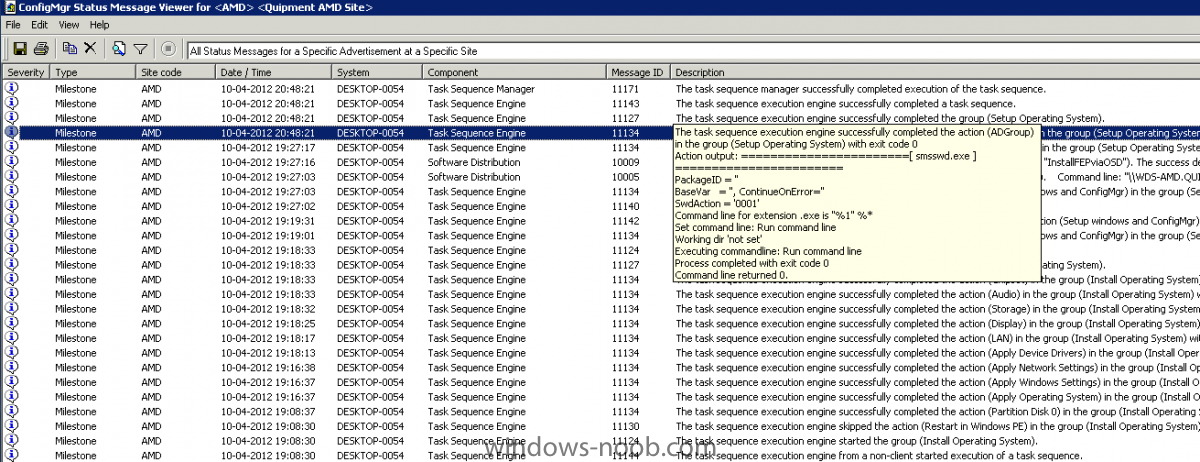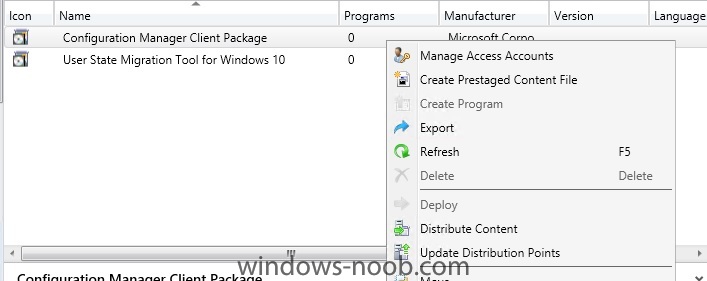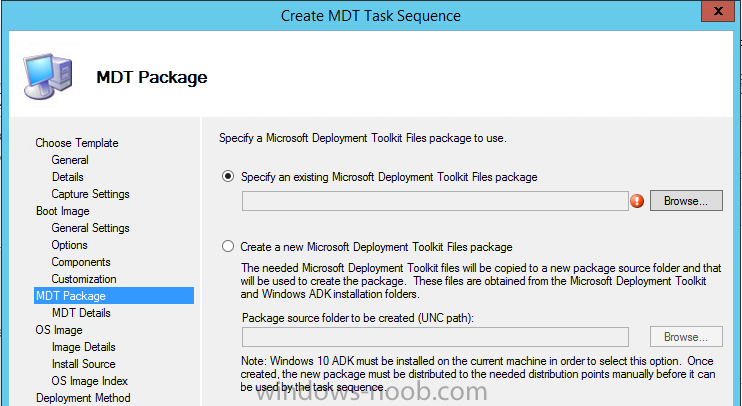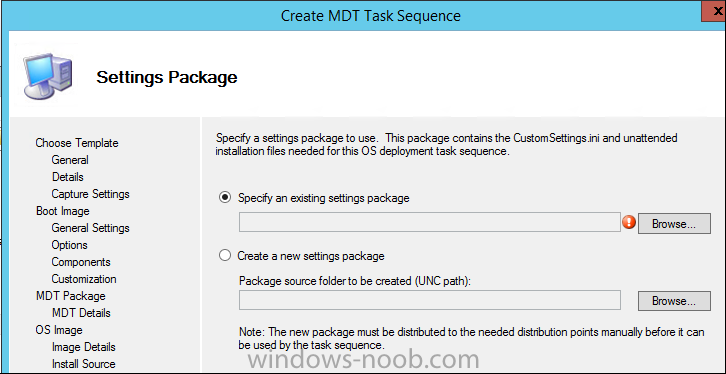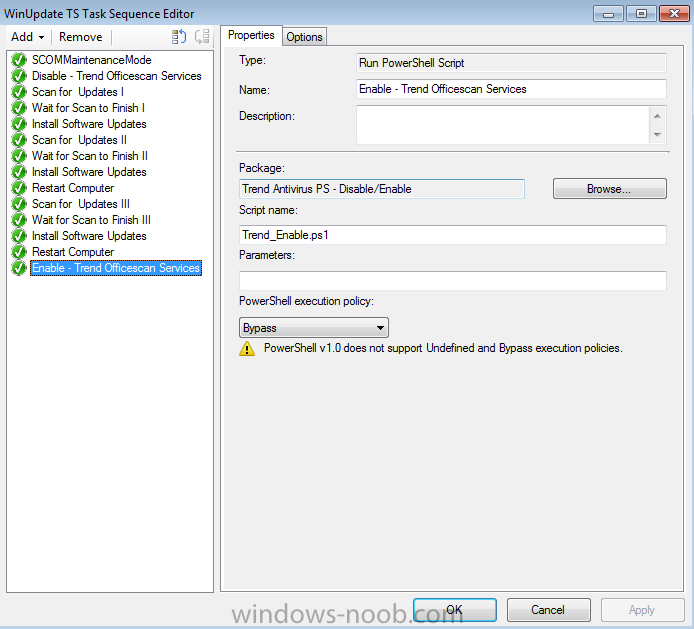Search the Community
Showing results for tags 'task sequence'.
-
Hey Guys / Niall - So I've got a bit of a challenge deploying some legacy apps right now. The installation process for many of these applications requires that files manually be copied to to local paths on the PC or certain registry settings added based on the location of the system. Easy to do with TS conditions, but finding a common variable between each of the locations is difficult. The locations they define are based on systems in specific OUs, but the OU formatting is different at each site (name of OU they give me could be at 3rd, 4th, or 5th level). I want a universal solution that I can use for all and all pretty much define different steps by the name of the OU the system is in. Below is what I came up with and have been trying to put together, but haven't had much luck - especially since my PowerShell isn't that great. The solution I came up with was to add the following in task sequences that needed it: Define TS variable for each name of OUs (which required different TS steps to be run) Per TS variable set above, run PowerShell script to grab system's DN then keyword search it for the TS variable's name If TS variable was found in DN string, set variable's value to TRUE else FALSE Create TS steps that copy the files as needed per site then set condition on it to run only if that site's TS variable had a TRUE value As for the PowerShell portion of this, below is what I have so far with comments per line... #Defines SCCM TS Variable Environment? $tsenv = New-Object -COMObject Microsoft.SMS.TSEnvironment #Reads variable from Task Sequence $v = $tsenv.Value("Site") #Grabs system's DN from Registry $dn = (Get-ItemProperty "HKLM:\SOFTWARE\Microsoft\Windows\CurrentVersion\Group Policy\State\Machine") | Select-Object -ExpandProperty distinguished-name #Searches DN string for TS Variable no matter case and sets it to $d (TRUE or FALSE) $d = $dn.ToLower().Contains($v.ToLower()) #Sets the original TS Variable "Site" to TRUE or FALSE $tsenv.Value("Site") = $d So far, no luck. So - is what I'm doing even possible? If so, what am I missing - or - any idea for a better way to go about this, perhaps? I tried to thing of something WMI-based, but couldn't Any ideas?
-
I am working on a Windows 10 pilot and trying to make a deployment available for users until a certain date. At that specific date I would like the task sequence to forcefully install. I have attached a pic of my current settings. It expires and forcefully installs but it does not allow the user to install prior at their convenience. Could anyone point me in the right direction? Thanks, RK
-
Error Message before UDI Starts in Task Sequence
TheWes posted a topic in Configuration Manager 2012
Hello, I built a UDI task sequence a while back and everything has been working fine. But lately, I have run into a problem where the process will fail right after it goes through the "Gather" stage, and right before it gets to the UDI. After some troubleshooting I came to the conclusion that it happens on a blank hard drive that has no partitions. If I boot up to a Windows installation disk and format and partition the drive first, then the task sequence will work properly. Has anyone else seen this or is it just me? Thanks! Wes- 1 reply
-
- sccm
- task sequence
-
(and 2 more)
Tagged with:
-
Hi I am using SCCM 2007 R3 and I am deploying Windows 7 x64 with SP1. I want to Add the computer to the security group of AD. I have created the .vbs script as below Option Explicit Dim objSysInfo, objComputer, strComputerDN Dim objComputerGroup ' Retrieve DN if user and local computer. Set objSysInfo = CreateObject("ADSystemInfo") strComputerDN = objSysInfo.ComputerName ' Bind to user and computer objects. Set objComputer = GetObject("LDAP://" & strComputerDN) ' Bind to groups. You must specify the full Distinguished Names. Set objComputerGroup = GetObject("LDAP://CN=IndiaDesktopgroup,OU=Desktops,OU=COmputers,OU=India,DC=mydomain,DC=local") ' Add user and computer to groups, if not already members. If (objComputerGroup.IsMember(objComputer.AdsPath) = False) Then objComputerGroup.Add(objComputer.AdsPath) End If 1.I have tried creating package and added progrgram into it and use that program into task sequence 2. I have also tried Adding command line in task sequence but didnt help. and error comes "incorrect function" Pls see the below task sequence and error log
-
I would like to install clean. but I don't know how do you setup the following task in sccm task sequence. My friend is using a script called gather local data and process rules with customsettings.ini file but i don't know how to use it For Non Existing Computer in AD Show all the task sequence Credential to use the whole process Check computer Model (if the driver exist for that model in Sccm source directory, proceed to next step) New Computer Number (Let me select the new computer number and check whether it is already exist or not) Organisation unit with drop down menu Summary before Proceed For existing Computer in AD Show only the specific task sequence ( if the computer was build as win 7 x86, show only task sequence win 7 x86) Credential to use the whole process Check computer Model (if the driver exist for that model in Sccm source directory, proceed to next step) Summary before proceed can we install AD group membership software (which is associated with the computer number) during windows deployment
-
Good afternoon, I have a windows 10 task sequence that lays down the OS nicely, installs all drivers, and activates windows/etc. We have kept fairly strict on standardizing the models of laptops/desktops that we purchase for our school district. We have a group of Lenovo T420 laptops that images perfectly with Windows 7 x86, but we just received a new batch and we're going to push Win10 x64 Professional to them. When getting the first one imaged, I noticed there were 4 or 5 drivers the task sequence did not take care of. I manually downloaded them, some of them only listed compatible with Windows 7 x64, but they worked fine with Win 10 x64, no issues whatsoever. I added those drivers to my sccm server, added them to my "x64 Lenovo Laptops" Driver Package, and updated them on my distribution point. I noticed when I right click the driver and go to the "Applicability" tab, it only had Windows 7 (64-bit) checked. I made sure Windows 10 Professional/Enterprise and higher (64-bit) was selected and even did 32-bit as well, applied, updated my distribution points, and I reran my OSD task sequence. Two drivers remain uninstalled after running the task sequence. 1) Base System Device, which is Ricoh PCIe SDXC/MMC Host Controller and 2) Intel® Active Management Technology - SOL I've double checked, readded the drivers to the packages/server, updated my distribution points and it does the same thing, only those two drivers WILL not install. What am I missing? Any help is appreciated, thank you!
-
Is it possible for me to use a task sequence to pre provision and setup bitlocker on an existing drive? I don't want to have to reinstall OS on existing machines in order to get this working. So, we have OS already installed and i want to use a task sequence to perhaps shrink volume and create a new bitlocker volume, then enable bitlocker.
-
I am trying to figure out a way to use a SCCM task sequence to set the initial screen resolution on our laptops. The Lenovo X1 Carbons have a super high resolution and I'd like to set those setting to 1080p. Any ideas? Everything I see about this seems to deal with resolution during PXE. I just want windows to have a certain resolution when I first logon on the laptop.
-
My task sequence fails with - "this task sequence cannot run because the program files for 00100002 cannot be located on a distribution point" (00100002 is config manager client). Does anyone have any idea why? I notice that my client package says 0 programs and has DEPLOY greyed out, so cant be deployed. Has anyone seen this before? the 'version' field is also blank
- 1 reply
-
- distribution point
- configuration manager
-
(and 1 more)
Tagged with:
-
Hello, This is my first post on this site and I'm hoping someone can help me. I'm using SCCM 2012 R2 and I was able to capture a Windows 7 Enterprise image from a reference PC for testing. I then deployed that image as a task sequence to another PC. My question is, why both PCs now have the same product ID under Windows Activation? Every other PC on my institution has a different license/product ID for each system. Do I have to use the build and capture guide instead? Thanks in advance.
- 3 replies
-
- Capture
- Task sequence
-
(and 1 more)
Tagged with:
-
Hi - I need some advice about where to search or what log to look at.... all of a sudden my Task Sequences for OSD are delayed in becoming available. For example: I deploy a TS to a collection but then when I boot, that TS isn't available for about a half hour and sometimes up to an hour. I have Googled Task Sequence logs, but I can't seem to find a log for just the process of deploying the TS to a collection, not the actual OSD itself. Any help would be appreciated. Jodi
-
Under the 'Advanced' tab on a task sequence, I've noticed the option "Disable this task sequence on computers where it is deployed." As I can't seem to find any details about that option other then the fact it exists, I'm curious as to how System Center detects this and then disables the task sequence for the device? Is there a way to clear it for a computer that is needing to be re-imaged after?
-
I work for a college and we have a windows 8 OS pre-existing in my lab. Those machines are frozen by DeepFreeze. I want to deploy another windows 8 OS to the same machines which will make them dual boot. We were using Ghost before and were able to do this by creating a separate partition and applying the OS to that partition. We moved to SCCM infrastructure recently and when I tried to accomplish this through the task sequence, the existing image get wiped out. Please help me with this.
-
Hi All, Would like to know if there's a way to create a new Status Filter variable (Eg. %msgsys, %msgsrc and etc.) . At the start of the TS, the user who kicked-off the TS requires to authenticate before proceeding. Would like to capture the user's details (email, givenname and sn), store these into a variable (Eg. %email, %givenname & %surname) then pass it to the SCCM Status Filter Rules. Regards, ej
-
- Status Messages
- Task Sequence
- (and 6 more)
-
Recently I updated my SCCM 2012 configuration manager to R2 SP1 in order to be able to be able to deploy Windows 10. Now I am trying to image machines using my old Task Sequences and my existing windows 7 captured images. I am able to boot and begin the old task sequences using the new boot images (Version 10.0.10586.0) but it errors out when it begins to apply the OS. As I understand the new boot images are supposed to support the deployment of Windows 7. I could use some help in troubleshooting this issue. I've included a video showing what happens during OSD deployment and the SMSTS.log file. Any help will be greatly appreciated. OSD Error on Apply OS.wmv smsts.log
- 4 replies
-
- task sequence fails
- Error: 80004004
- (and 5 more)
-
Hello Folks, Long time Windows Noob fan, first time poster... I have a question about a Task Sequence in SCCM with MDT... So when creating a TS via MDT, you'll have that nice wizard that helps you out and I could not find anything that would define when to create a new XYZ Package and when to reuse it or not reuse it in another SCCM MDT Task Sequence... Create MDT Task Sequence > Boot Image Step > you have a choice to use an existing one or create a new one... Since I only have the stock SCCM Boot images, i do want to make an MDT boot image for x86 and x64... - Can I use these MDT Boot Images for another TS, if yes, when would i want to create another set of MDT Boot Images x86 and x64? Create MDT Task Sequence > MDT Package Step > you have a choice to use an existing or create a new one. When you create a new one, the folders at the given UNC Path look like as if it is a new deployment share which you would use for WorkBench. - Can I use this MDT Package for another TS, if yes, when would i want to create another set of MDT Packages? Also, what is the best practices for naming convention or organization? Create MDT Task Sequence > CustomSettings.ini Step > again, you have a choice to use an existing or create a new one. Since i dont have one, i'd create a new one but when would you want to reuse it and when would you want to create a brand new one? For all 3, i feel like if i make a new anything, i should make a new folder though i'm not quite sure what the best folder plan is for organization would be. Thank you for any help, i really do appreciate it!
-
I have made a task to update drivers for a lenovo E550 Laptop. First task: command line (Run ThinINstaller TrustZone) cmd /c C:\Windows\Microsoft.NET\Framework\v4.0.30319\CasPol.exe –pp off –m –ag 1.2 –url file://\\x.x.x.x\Sources\os_drivers\Laptops\E550\ FullTrust Disable 64-bit file systems redirection Second task: command line (CMD Copy ThinInstaller) cmd /c xcopy.exe "\\x.x.x.x\Sources\ThinInst\*.*" C:\Thinstaller\ /E /D Time-outs: 15 minutes Third Task: command line (CMD Run ThinInstaller) cmd /c C:\Thinstaller\thininstaller.exe /CM -search A -action INSTALL -noicon -includerebootpackages 1,2,3,4 -repository "\\x.x.x.x\Sources\os_drivers\Laptops\E550" -log "C:\Thinstaller\tvsulog.txt" Start in: C:\Thinstaller Time-outs: 120 minutes Error: Failed to run the action: Run ThinINstaller TrustZone. Incorrect function. (Error: 00000001; Source: Windows) Expand a string: smsswd.exe /run: cmd /c %windir%\Microsoft.NET\Framework\v4.0.30319\CasPol.exe –pp off –m –ag 1.2 –url file://\\x.x.x.x\Sources\os_drivers\Laptops\E550\ FullTrust TSManager 1/11/2016 7:16:25 PM 268 (0x010C) Expand a string: TSManager 1/11/2016 7:16:25 PM 268 (0x010C) Command line for extension .exe is "%1" %* TSManager 1/11/2016 7:16:25 PM 268 (0x010C) Set command line: smsswd.exe /run: cmd /c %windir%\Microsoft.NET\Framework\v4.0.30319\CasPol.exe –pp off –m –ag 1.2 –url file://\\x.x.x.x\Sources\os_drivers\Laptops\E550\ FullTrust TSManager 1/11/2016 7:16:25 PM 268 (0x010C) Start executing the command line: smsswd.exe /run: cmd /c %windir%\Microsoft.NET\Framework\v4.0.30319\CasPol.exe –pp off –m –ag 1.2 –url file://\\10.160.14.25\Sources\os_drivers\Laptops\E550\ FullTrust TSManager 1/11/2016 7:16:25 PM 268 (0x010C) !--------------------------------------------------------------------------------------------! TSManager 1/11/2016 7:16:25 PM 268 (0x010C) Expand a string: WinPEandFullOS TSManager 1/11/2016 7:16:25 PM 268 (0x010C) Executing command line: smsswd.exe /run: cmd /c %windir%\Microsoft.NET\Framework\v4.0.30319\CasPol.exe –pp off –m –ag 1.2 –url file://\\x.x.x.x\Sources\os_drivers\Laptops\E550\ FullTrust TSManager 1/11/2016 7:16:25 PM 268 (0x010C) [ smsswd.exe ] InstallSoftware 1/11/2016 7:16:25 PM 1168 (0x0490) PackageID = '' InstallSoftware 1/11/2016 7:16:25 PM 1168 (0x0490) BaseVar = '', ContinueOnError='' InstallSoftware 1/11/2016 7:16:25 PM 1168 (0x0490) ProgramName = 'cmd /c X:\WINDOWS\Microsoft.NET\Framework\v4.0.30319\CasPol.exe –pp off –m –ag 1.2 –url file://\\x.x.x.x\Sources\os_drivers\Laptops\E550\ FullTrust' InstallSoftware 1/11/2016 7:16:25 PM 1168 (0x0490) SwdAction = '0001' InstallSoftware 1/11/2016 7:16:25 PM 1168 (0x0490) Set command line: Run command line InstallSoftware 1/11/2016 7:16:25 PM 1168 (0x0490) Working dir 'not set' InstallSoftware 1/11/2016 7:16:25 PM 1168 (0x0490) Executing command line: Run command line InstallSoftware 1/11/2016 7:16:25 PM 1168 (0x0490) Process completed with exit code 1 InstallSoftware 1/11/2016 7:16:25 PM 1168 (0x0490) Command line returned 1 InstallSoftware 1/11/2016 7:16:25 PM 1168 (0x0490) Process completed with exit code 1 TSManager 1/11/2016 7:16:25 PM 268 (0x010C) !--------------------------------------------------------------------------------------------! TSManager 1/11/2016 7:16:25 PM 268 (0x010C) Failed to run the action: Run ThinINstaller TrustZone. Incorrect function. (Error: 00000001; Source: Windows) TSManager 1/11/2016 7:16:25 PM 268 (0x010C) Can anyone help me out?
-
Hi there Hopefully someone can help me out here. I plan on using a custom UDI Task Sequence to deploy a particular software package in our organization. The reason why a Task Sequence is been used is that we want to able to allow local admins/users choose the language of the software package that gets installed. I actually have it working already where, depending what a user chooses in the UDI, triggers a Task Sequence variable to run and install the particular language that the user had chosen. This works just fine and will probably suffice for our needs but i was hoping to add some more logic into the TS so that it would detect the OS language that the user has and then have the equivalent language of the software package already selected when they reached the the selection screen. As an example, if a user happened to have a Japanese OS, then when they came to the selection screen for the software package, the Japanese version would be automatically selected. I have already done something similar in the past with an OSD scenario (using CustomSettings.ini) where the default gateway IP determines what the timezone, keyboard settings, etc are automatically selected but what i'm trying to attempt right now is a "refresh" scenario, i.e., the TS will run inside the Windows OS and not PE. Anyone have any ideas on this? Thank you.
-
- task sequence
- variables
-
(and 2 more)
Tagged with:
-
Hello all, hopefully you can help solving this issue that's bugging me for quite a time. When we're deploying new computers, or computers that are not in the sccm database, we use the OsdComputername variable to name the computer, it's working well but when I'm looking for the logs in the console under system status> advertisment status the default computer name (minint-xxx) appears in the system column instead of the given name, until the task "Setup windows and ConfigMgr" has completed (and still the new name is displayed only for the "Software Distribution" component. here is a screenshot of what I see, it's not really important for 1 or 2 computer but when we're deploying 100 at the same time it's impossible to troubleshoot. https://skydrive.liv...3E677D04EA!5652 so how could we have the name we had specified in the osdcomputername variable at the start of the task sequence displayed in the "system" name in the status messages report? I know there is the the _SMSTSMachineName buit in variable but i'm sure how I can use that in my task sequence. thanks
- 1 reply
-
- sccm
- task sequence
-
(and 4 more)
Tagged with:
-
Hi Everyone, I am trying to automate MBAM Encryption during the OSD Task Sequence using the "StartMBAMEncryption.wsf" script provided in the following blog. http://blogs.technet.com/b/deploymentguys/archive/2012/02/20/using-mbam-to-start-bitlocker-encryption-in-a-task-sequence.aspx The command I use is - cscript.exe StartMBAMEncryption.wsf /MBAMServiceEndPoint:http://<MBAM Server Name>/MBAMRecoveryAndHardwareService/CoreService.svc I have used the script in both a "Install a Package" & "Run Command Line" group & both fail with the below error. Failed to run the action: Install a Package The system cannot find the file specified. (Error: 80070002; Source: Windows) Yet if I exit out of the Task Sequence, log onto the Laptop, & run the exact same command, MBAM Encryption starts first time without any problems. Any help would be much appreciated. Thanks! Jordan,
-
I am trying to build and capture a Winddows 7 X64 Image using SCCM 2012 R2 (SP1). I have also installed Cumulative Updates 1 for R2 SP1 and made sure the client Patches CU1 during setup. I have been using Software Updates to clients on the Domain successfully but the OSD is failing to complete with the error "timeout period expired. Error: 800705B4" in the SMSTS.log (see attached). I have ensured the Client install includes the following (note the FQDN is different to this, trying to not publish to the world): SMSMP=server.com SMSSLP=server.com DNSSUFFIX=com I have added the hotfix KB2522623 and also included the following command prior to the updates: WMIC /namespace:\\root\ccm path sms_client CALL TriggerSchedule "{00000000-0000-0000-0000-000000000113}" /NOINTERACTIVE I have made sure the client correctly connects with an IP on the active Boundary. Also I have made sure the updates are correctly Distributed to the DP. I am at a loss for what is happening here? Please see SMSTS.log, SoftwareUpdates.log, UpdatesHandler.log, UpdatesDeployment.log, UpdatesStore.log, and WUAHandler.log below for more info. Here is excerpt from SMSTS.log when it fails: executing command: C:\Windows\system32\cmd.exe /k executed command: C:\Windows\system32\cmd.exe /k FALSE, HRESULT=800705b4 (e:\nts_sccm_release\sms\client\osdeployment\installswupdate\installswupdate.cpp,1273) Timedout waiting for updates refresh complete notification WaitForRefreshUpdatesComplete(spInstall), HRESULT=800705b4 (e:\nts_sccm_release\sms\client\osdeployment\installswupdate\installswupdate.cpp,1331) RefreshUpdates(), HRESULT=800705b4 (e:\nts_sccm_release\sms\client\osdeployment\installswupdate\installswupdate.cpp,923) InstallUpdates(pInstallUpdate, tType, sJobID, sActiveRequestHandle), HRESULT=800705b4 (e:\nts_sccm_release\sms\client\osdeployment\installswupdate\main.cpp,248) Setting TSEnv variable SMSTSInstallUpdateJobGUID= Process(pInstallUpdate, tType), HRESULT=800705b4 (e:\nts_sccm_release\sms\client\osdeployment\installswupdate\main.cpp,302) Process completed with exit code 2147943860 !--------------------------------------------------------------------------------------------! Failed to run the action: Install Software Updates 1st Pass. This operation returned because the timeout period expired. (Error: 800705B4; Source: Windows) MP server http://SERVER.comPorts 80,443. CRL=false. Setting authenticator Set authenticator in transport Sending StatusMessage Setting message signatures. Setting the authenticator. CLibSMSMessageWinHttpTransport::Send: URL: SERVER.com:80 CCM_POST /ccm_system/request Request was successful. Set a global environment variable _SMSTSLastActionRetCode=-2147023436 Set a global environment variable _SMSTSLastActionSucceeded=false Clear local default environment The execution engine ignored the failure of the action (Install Software Updates 1st Pass) and continues execution smsts.log UpdatesDeployment.log UpdatesHandler.log UpdatesStore.log WUAHandler.log WindowsUpdate.log
- 5 replies
-
- build and capture
- osd
-
(and 2 more)
Tagged with:
-
Running simple scripts from %ScriptRoot%
danhowitt posted a question in Microsoft Deployment Toolkit (MDT)
Hello I am trying to put together an imaging process for where I work using MDT and WDS, I am learning to do it as I do it and so there is much much I not understand. Does MDT copy the %ScriptRoot% some where on to the C drive? If I say wanted to copy a file from the deployment share on to the C drive how would I go about doing this? When you execute a script you have placed in %ScriptRoot% how do you give the script access to a network share and the local C drive of the client computer simultaneously if you say wanted to copy a file from the share to local c drive? Or maybe this is already done for you if you place it in %ScriptRoot% - if not is it possible to edit the scripts such as LTICopyScripts.wsf and get it to copy your custom script across for you so you can then run it with only local permissions. Just seems to be a pants way of doing things - there must be something I am missing? I have spent a long time googling and searching forums and maybe its an easy answer (hopefully) but I am struggling - if you can point me in the right direction that would be awesome! Thanks Dan- 1 reply
-
- mdt
- task sequence
-
(and 2 more)
Tagged with:
-
Hi, I have created a TS to disable the antivirus (Trend - PS script) and then do a Software Update cycle and install Windows Updates on our servers - see: The plan is to reduce manual intervention and hours of work, watching and waiting - for our manual servers (ie clusters etc) However I find I have to login to run this or it fails, then when it does the restart step I have to login again to complete it. Any ideas on how I can get this to run under Computer permissions so I can push it out to multiple computers without having to login. Anything else I should be adding/any ideas?
-
- sccm
- windows update
-
(and 1 more)
Tagged with:
-
Hi forum, I've added this command into my task sequence but unfortunately I still have to log in after the build has completed and click on Activate. I don't need to enter a licence key as that's in the T/S. When I run this command from a Run command it says it needs elevated privileges to run. Any idea how incorporate this into the command? cscript.exe %windir%\system32\slmgr.vbs /ato Thanks
- 6 replies
-
- windows 7
- activation
-
(and 2 more)
Tagged with:
-
Hi everyone! I am experiencing a weird issue with a newly created task sequence in our new CM12 environment. This is a brand new install of CM12 R2 SP1, and nothing was migrated over from the old environment. We are a small shop with a simple environment, one single site server. I've created the OSD task sequence using our custom WIM that was captured in our old MDT/WDS environment (MDT 2012, not sure specific version) with ADK 8.1. The issue I'm having is that the task sequence hangs during the "Applying Operating System" step, and it doesn't go anywhere. I am working off-site today and have not had the opportunity to look at it, but a coworker did tell me it was sitting at a black screen with the message "No operating system installed, press Ctrl + Alt + Del to restart" which tells me the OS did not install properly. I was looking through SMSTS.log and didn't notice anything peculiar, but it seemed to stop logging after that step began. I've been Googling and asking others, but I'm at a loss right now. Is there a way to turn on verbose logging for task sequences? This is my first foray into using OSD, I've only used MDT/WDS in the past. Any help is appreciated. Thanks much!





